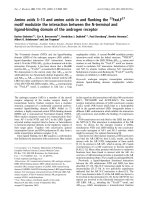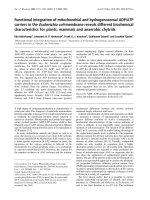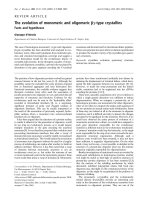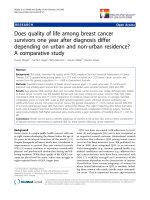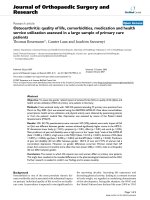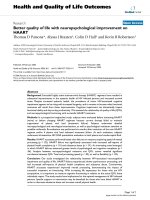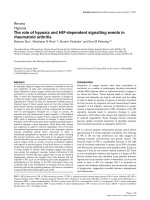Báo cáo y học: " Health-related quality of life and long-term prognosis in chronic hypercapnic respiratory failure: a prospective survival analysis" docx
Bạn đang xem bản rút gọn của tài liệu. Xem và tải ngay bản đầy đủ của tài liệu tại đây (402.5 KB, 9 trang )
BioMed Central
Page 1 of 9
(page number not for citation purposes)
Respiratory Research
Open Access
Research
Health-related quality of life and long-term prognosis in chronic
hypercapnic respiratory failure: a prospective survival analysis
Stephan Budweiser*
†1
, Andre P Hitzl
†1
, Rudolf A Jörres
2
,
Kathrin Schmidbauer
1
, Frank Heinemann
1
and Michael Pfeifer
1,3
Address:
1
Center for Pneumology, Donaustauf Hospital, Donaustauf, Germany,
2
Institute and Outpatient Clinic for Occupational and
Environmental Medicine, Ludwig-Maximilians-University, Munich, Germany and
3
Department of Internal Medicine II, Division of Respirology,
University of Regensburg, Regensburg, Germany
Email: Stephan Budweiser* - ; Andre P Hitzl - ;
Rudolf A Jörres - ; Kathrin Schmidbauer - ;
Frank Heinemann - ; Michael Pfeifer -
* Corresponding author †Equal contributors
Abstract
Background: Health-related quality of life (HRQL) is considered as an important outcome parameter in
patients with chronic diseases. This study aimed to assess the role of disease-specific HRQL for long-term
survival in patients of different diagnoses with chronic hypercapnic respiratory failure (CHRF).
Methods: In a cohort of 231 stable patients (chronic obstructive pulmonary disease (COPD), n = 98; non-
COPD (obesity-hypoventilation syndrome, restrictive disorders, neuromuscular disorders), n = 133) with
CHRF and current home mechanical ventilation (HMV), HRQL was assessed by the disease-specific Severe
Respiratory Insufficiency (SRI) questionnaire and its prognostic value was prospectively evaluated during a
follow-up of 2–4 years, using univariate and multivariate regression analysis.
Results: HRQL was more impaired in COPD (mean ± SD SRI-summary score (SRI-SS) 52.5 ± 15.6) than
non-COPD patients (67.6 ± 16.4; p < 0.001). Overall mortality during 28.9 ± 8.8 months of follow-up was
19.1% (31.6% in COPD, 9.8% in non-COPD). To identify the overall role of SRI, we first evaluated the total
study population. SRI-SS and its subdomains (except attendance symptoms and sleep), as well as body mass
index (BMI), leukocyte number and spirometric indices were associated with long-term survival (p < 0.01
each). Of these, SRI-SS, leukocytes and forced expiratory volume in 1 s (FEV
1
) turned out to be
independent predictors (p < 0.05 each). More specifically, in non-COPD patients SRI-SS and most of its
subdomains, as well as leukocyte number, were related to survival (p < 0.05), whereas in patients with
COPD only BMI and lung function but not SRI were predictive.
Conclusion: In patients with CHRF and HMV, the disease-specific SRI was an overall predictor of long-
term survival in addition to established risk factors. However, the SRI predominantly beared information
regarding long-term survival in non-COPD patients, while in COPD patients objective measures of the
disease state were superior. This on one hand highlights the significance of HRQL in the long-term course
of patients with CHRF, on the other hand it suggests that the predictive value of HRQL depends on the
underlying disease.
Published: 17 December 2007
Respiratory Research 2007, 8:92 doi:10.1186/1465-9921-8-92
Received: 10 October 2007
Accepted: 17 December 2007
This article is available from: />© 2007 Budweiser et al; licensee BioMed Central Ltd.
This is an Open Access article distributed under the terms of the Creative Commons Attribution License ( />),
which permits unrestricted use, distribution, and reproduction in any medium, provided the original work is properly cited.
Respiratory Research 2007, 8:92 />Page 2 of 9
(page number not for citation purposes)
Background
Home mechanical ventilation (HMV) is an established
approach in the treatment of severe, chronic hypercapnic
respiratory failure (CHRF). The number of patients treated
with HMV has much increased and will rise further with
medical advance and the ageing of the population [1].
However, the knowledge on clinical outcome measures
during current HMV that could be valuable for long-term
follow-up and for estimation of survival, is limited [2,3].
In chronic obstructive pulmonary disease (COPD), the
degree of airway obstruction insufficiently represents the
systemic aspects of the disease [4]. Accordingly, body
mass index (BMI) and six-minute walk distance (6-MWD)
have been revealed as prognostic markers [5]. Moreover,
long-term survival is linked to the patients' perception of
functional limitations, expressed as degree of dyspnoea
[6]. There is also evidence for an association with health-
related quality of life (HRQL) in terms of disease-specific
[7,8] or generic measures [7,9]. Intuitively, self-reported
health-status has the potential to integrate diverse aspects
of disease severity and prognosis [8].
Patients with CHRF might not only suffer from COPD but
also from severe restrictive diseases (RD), neuromuscular
disorders (NMD), or obesity-hypoventilation syndrome
(OHS). In many of these patients nutritional depletion or
systemic inflammation is present [10-14] and associated
with survival, as in COPD [2,3], while the relationship
between other measures and long-term prognosis might
be different [15-17]. In addition, psycho-social factors are
relevant in these chronic respiratory diseases [18-21] and
could also determine long-term survival.
To account for the specific conditions of the disorders
underlying CHRF, the Severe Respiratory Insufficiency
(SRI) questionnaire has been introduced [22], providing a
comprehensive, multidimensional picture. It can be
hypothesized that this reflects features that are common
in CHRF and related to prognosis, particularly under the
relatively stable conditions achieved by HMV. We thus
evaluated the association between disease-specific HRQL
and long-term survival, comparing its predictive value
with that of known risk factors. The analysis was per-
formed in two-step manner, first identifying the role of
HRQL in the total study population and then elucidating
the role in patients with or without COPD.
Methods
Population
Between December 1
st
, 2002, and November 30
th
, 2004,
consecutive patients with current nocturnal HMV (since ≥
3 months) due to CHRF were prospectively recruited dur-
ing a routine follow-up investigation. The underlying dis-
eases comprised COPD, severe RD, OHS/overlap
syndrome or NMD.
All patients were categorized according to their primary
diagnosis upon initiation of HMV. The diagnosis of
COPD relied on symptoms and airflow limitation (ratio
of forced expiratory volume in one second to inspiratory
vital capacity (FEV
1
/FVC) < 0.7) [23]. OHS was character-
ized by BMI > 30 kg/m
2
, daytime arterial carbon dioxide
tension (PaCO
2
) ≥ 45 mmHg prior to HMV and symp-
toms of CHRF in the absence of other significant causes of
hypoventilation based on the physician's judgement [15].
Patients with hypercapnia as a result of confirmed sleep
apnoea and minor airway obstruction were classified as
"overlap syndrome" (OL) [24]. Participants had to be in a
stable clinical condition without signs of current exacer-
bation or respiratory tract infection. The study was
approved by the Institutional Review Board of the Univer-
sity of Regensburg and patients gave their informed con-
sent.
Assessments and protocol
Upon inclusion the SRI questionnaire, blood gases, labo-
ratory parameters and the presence of comorbidities were
assessed, as well as lung function measurements per-
formed.
The SRI questionnaire comprises 49 questions across 7
domains covering respiratory complaints (RC), physical
functioning (PF), attendant symptoms and sleep (AS),
social relationship (SR), anxiety (AX), psychological well-
being (PW), and social functioning (SF). These subscales
are aggregated into one summary score (SRI-SS), whereas
high values indicate high HRQL and converse [22]. For
data evaluation the values obtained from the question-
naire were scaled from 0 to 100 analogous to the compu-
tation of percentages.
Capillary blood gases (Rapidlab; Bayer Inc; East Walpole,
MA, USA) were analyzed during spontaneous breathing of
room air if possible or otherwise during the patients' usual
oxygen flow. Spirometry (MasterScreen, Viasys Inc., Würz-
burg, Germany) including assessment of (IVC), was per-
formed according to ATS guidelines [25], and ERS
reference values [26] were used. Among the available rou-
tine laboratory parameters which were obtained by stand-
ard procedures, we selected haemoglobin level and
leukocyte number for analysis (Micros 60-CT, ABX Inc.,
Montpellier, France). Additionally, comorbidities as taken
from the medical records or diagnosed de novo during the
initial hospital stay were documented.
Follow-up
Patients were routinely admitted every 6 months for re-
evaluation of their respiratory status. This included the
Respiratory Research 2007, 8:92 />Page 3 of 9
(page number not for citation purposes)
assessment of adverse effects of HMV treatment (leakage,
dry mucosal, etc.) and treatment efficacy by a standard-
ized procedure. Pulmonary function test were performed
as described above. At this visit also ventilatory parame-
ters were optimized, guided by nocturnal capillary blood
gas values and oxygen saturation. Adherence to HMV was
evaluated from the time counter readings of the ventilator
and the duration of HMV was calculated in months from
the day of initiation.
All patients were followed until death or the end of the
study period at November 30
th
, 2006. In patients who
could not be re-assessed in the hospital until this closing
date, vital status was assessed through telephone interview
of the patients' relatives and/or family doctors, or by
reviewing the medical records supplied by other medical
institutions. Deaths from either respiratory or any cause
were recorded.
Statistical analysis
Data for continuous variables are presented as mean ±
standard deviation (SD) or as median values and quar-
tiles, depending on whether the data showed normal dis-
tribution or not. Groups were compared by analysis of
variance (ANOVA) with post hoc comparisons according to
Newman-Keuls, alternatively the unpaired t-test or the
Mann-Whitney U-test for quantitative variables (with
appropriate Bonferroni correction), or by Fisher's exact
test for binary variables. Univariate survival analysis was
performed by Kaplan-Meier analysis (log-rank test), start-
ing by the day of inclusion to the closing date. As cut-off
we used median or quartile values. Multivariate Cox
regression analysis was employed to identify independent
predictors. P-values < 0.05 were considered statistically
significant. All analyses were performed by the statistical
software packages SPSS (version 12.0, Chicago, IL, USA)
and MedCalc (version 9.2.0.1., Mariakerke, Belgium).
Results
Patients' characteristics
Of 262 eligible patients to whom the questionnaire was
handled, 12 provided incomplete and 10 non-usable
answers, while 9 patients rejected the questionnaire. Thus
the study population (Table 1) comprised 231 patients
(145 male, 86 female) with CHRF due to either very severe
COPD (n = 98) of GOLD (Global Initiative for Chronic
Obstructive Lung Disease [23]) stage IV, OHS/OL (n = 54/
15), RD (n = 49; comprising chest-wall disease (n = 37),
post-tuberculosis syndrome (n = 8), lung fibrosis (n = 3),
silicosis (n = 1)), or NMD (n = 15).
Table 1: Baseline characteristics of patients according to the aetiology of CHRF.
Parameter All patients COPD RD NMD OHS/OL
N 231 98 49 15 69
Gender (f/m) 86/145 28/70 28/21 ** 5/10 25/44
Age (yrs) 62.9 ± 10.2 64.6 ± 8.2 63.2 ± 12.0 62.8 ± 7.1 60.3 ± 11.4 ***
BMI (kg/m
2
) 33.2 ± 9.9 29.4 ± 7.0 29.3 ± 5.6 28.9 ± 10.0 42.3 ± 9.9 ***
Ventilator use (h/d) 6.76 ± 2.52 6.70 ± 2.81 7.16 ± 2.11 7.20 ± 2.37 6.47 ± 2.39
Duration of HMV (months) 28.9 ± 8.8 29.6 ± 28.3 45.2 ± 36.9 * 27.4 ± 25.5 32.1 ± 25.2
Hb (g/dL) 13.7 ± 1.6 13.9 ± 1.7 13.7 ± 1.5 13.7 ± 1.2 13.5 ± 1.7
Leukocyte number (10
3
/µL) 8.97 ± 3.13 10.1 ± 3.5 7.5 ± 2.3 *** 7.2 ± 2.5* 8.8 ± 2.6 *
Heart disease, N (%) 65 (28.1) 29 (29.6) 11 (22.4) 5 (33.3) 20 (29.0)
Diabetes, N (%) 41 (17.7) 20 (20.4) 4 (8.1) 2 (13.3) 15 (21.7)
Hyperlipidaemia, N (%) 27 (11.7) 11 (11.2) 7 (14.2) 1 (6.7) 8 (11.6)
Hypertension, N (%) 121 (52.4) 42 (42.8) 22 (44.9) 7 (46.7) 50 (72.5) ***
FEV
1
(L) 1.25 ± 0.71 0.85 ± 0.26 0.89 ± 0.34 1.25 ± 0.58 * 2.08 ± 0.68 ***
FEV
1
(%pred) 48.7 ± 22.3 32.7 ± 8.7 44.0 ± 14.6 ** 50.3 ± 24.0 ** 73.9 ± 17.1 ***
FEV/IVC (%) 61.9 ± 17.8 45.8 ± 9.2 74.3 ± 9.9 *** 87.4 ± 17.2 *** 70.3 ± 11.4 ***
IVC (L) 2.05 ± 0.95 1.91 ± 0.55 1.19 ± 0.44 *** 1.44 ± 0.66 ** 2.98 ± 0.94 ***
IVC (%pred) 70.0 ± 21.2 56.3 ± 13.9 48.4 ± 16.5 ** 46.2 ± 22.6 * 82.8 ± 16.3 ***
pH 7.42 ± 0.04 7.42 ± 0.03 7.42 ± 0.04 7. 43 ± 0.03 7.43 ± 0.04
PaO
2
(mmHg) 68.0 ± 16.0 66.8 ± 16.2 71.1 ± 18.1 69.2 ± 19.1 67.2 ± 13.3
PaCO
2
(mmHg) 44.2 ± 6.8 46.4 ± 6.7 44.7 ± 6.6 40.5 ± 6.0** 41.6 ± 6.2 ***
BE (mmol/L) 3.93 ± 3.04 4.76 ± 3.33 3.84 ± 2.57 2.86 ± 2.06* 3.06 ± 2.81 **
Data are shown as mean ± SD. Characteristics of patients with COPD were compared with those of patients with other diseases using the unpaired
t-test, Mann-Whitney U-test, or Fisher's exact test. P-values for individual tests were *p < 0.05; **p < 0.017 (corresponding to an overall p < 0.05
using a Bonferroni correction for three comparisons); ***p < 0.001. Definition of abbreviations: COPD = chronic obstructive pulmonary disease; RD
= restrictive disease; NMD = neuromuscular disease; OHS = obesity-hypoventilation syndrome; OL = overlap syndrome: BMI = body-mass index;
HMV = home mechanical ventilation; Hb = haemoglobin; FEV
1
= forced expiratory volume in one second; IVC = inspiratory vital capacity; PaO
2
=
arterial oxygen tension; PaCO
2
= arterial carbon dioxide tension; BE = base excess. Blood gas parameters were obtained while patients were
breathing room air (n = 147) or their usual oxygen flow (n = 84).
Respiratory Research 2007, 8:92 />Page 4 of 9
(page number not for citation purposes)
Home ventilators were set at a volume- or pressure-cycled
assist-controlled mode. Patients were ventilated via nasal
(95.2%) or full-face (3.1%) mask or tracheostomy
(1.7%). Median (quartiles) expiratory pressure was 4 (3;
5) cmH
2
O, inspiratory pressure 20 (18; 24) cmH
2
O, and
respiratory frequency 19 (16; 22)/min. Patients had spent
25.1 (8.1; 49.7) months on nocturnal HMV prior to enrol-
ment; ventilator use was 6.8 (4.8; 8.3) h/day. Long term
oxygen therapy (LTOT) was administered in 81% of
patients (96% COPD, 70% RD, 53% NMD, 74% OHS/
OL).
SRI-SS differed significantly between groups (ANOVA, p <
0.001; Table 2), specifically between COPD (52.5 ± 15.6)
and non-COPD (67.6 ± 16.4; p < 0.001). According to
Newman-Keuls there were two homogeneous groups for
SRI-SS: COPD showed similar values as NMD, and RD
similar values as OHS/OL. SRI-SS was not different
between OL and OHS (p = 0.491). Values did also not dif-
fer between male and female or non-invasively ventilated
and tracheostomised (n = 4) patients, nor depend on the
fact whether nasal or face masks were used nor whether
patients had LTOT nor not. The subdomains showed very
similar results as the SRI-SS (Table 2).
Long-term survival and prognostic factors in the total
population
In the total population (n = 231), the mean observation
time was 28.9 ± 8.8 months, ranging from 0.2 (death one
week after discharge) to 45.8 months. During the study
period, 44 patients died (overall mortality 19.1%; COPD
31.6% (n = 31), non-COPD 9.8% (OHS n = 7, RD n = 6)),
either from respiratory (n = 29; 65.9%), or non-respira-
tory (n = 3; 6.8%), or not further specified causes (n = 12;
27.3%).
In the total population survival rates (standard error) at 1,
2 and 3 years were 93.1 (1.7), 84.3 (2.4), and 78.4 (3.0)
%, respectively. In COPD, the respective values were 85.7
(3.5), 72.4 (4.5) and 65.3 (5.3) %, and in non-COPD
98.5 (1.1), 93.1 (2.2), and 88.1 (3.2) %. Survival differed
between COPD and non-COPD (p < 0.001; HR 0.266;
95%-CI 0.139–0.508), but not between NMD, OHS/OL,
or RD. The fact whether patients were ventilated via nasal,
full-face mask or tracheostomy was not related to survival,
similarly as for LTOT.
In univariate analyses, BMI, leukocyte number, base
excess (BE), FEV
1
and FEV
1
/IVC were significantly associ-
ated with survival in the total population (Table 3). Nei-
ther gender nor comorbidities including heart disease,
diabetes, hyperlipidaemia and systemic hypertension, nor
medication were related to survival. Regarding SRI, all
subscores, with the exception of attendant symptoms and
sleep (AS), were predictors of survival (Table 3). Accord-
ingly, SRI-SS was predictive when using the median (Fig-
ure 1, panel A) or quartile values (Figure 1, panel B) as cut-
off.
Stepwise multivariate Cox regression analysis, including
the quantitative factors identified in univariate analyses
(BMI, leukocytes, BE, FEV
1
, FEV
1
/IVC, SRI-SS) revealed as
independent predictors in the total population leukocyte
number (HR 2.693, 95%-CI 1.349–5.375; p = 0.005),
FEV
1
(HR 0.313, 95%-CI 0.152–0.644; p = 0.002) and
SRI-SS (HR 0.383, 95%-CI 0.186–0.789; p = 0.009). To
assess whether the difference in survival between COPD
and non-COPD influenced this result, the analysis was
repeated by including disease category as binary (COPD
versus non-COPD) variable. Again, FEV
1
, SRI-SS and leu-
kocytes were independent risk factors (p < 0.05), whereas
disease category did not show any more a significant asso-
ciation in this multivariate analysis (p = 0.192). When dis-
ease category was added as variable to each of the other
variables in separate analyses, these variables were still
predictors in addition to the disease (p < 0.05 each).
Table 2: Results of SRI questionnaire within subgroups.
SRI – subscore All (n = 231) COPD (n = 98) RD (n = 49) NMD (n = 15) OHS/OL (n = 69)
Respiratory complaints 61.2 ± 19.8 50.9 ± 17.5 65.8 ± 17.7*** 59.4 ± 13.9* 72.3 ± 18.7***
Physical functioning 49.4 ± 24.9 38.2 ± 21.6 55.0 ± 24.7** 33.6 ± 18.0 64.2 ± 22.0***
Attendant symptoms/sleep 63.6 ± 19.0 58.9 ± 18.2 65.8 ± 19.4 59.0 ± 16.5 69.4 ± 19.1***
Social relationship 71.9 ± 18.5 64.9 ± 19.9 75.8 ± 14.6** 68.8 ± 14.3 79.3 ± 16.5***
Anxiety 62.5 ± 23.6 51.8 ± 21.6 66.9 ± 24.2** 61.7 ± 19.1 74.1 ± 20.7***
Psychological wellbeing 62.9 ± 19.6 55.7 ± 19.2 68.3 ± 19.0** 53.6 ± 12.7 70.9 ± 17.4***
Social functioning 58.2 ± 23.3 47.3 ± 20.9 66.2 ± 23.7*** 50.3 ± 16.6 68.8 ± 21.5***
Summary score 61.2 ± 17.7 52.2 ± 15.6 66.2 ± 17.2*** 55.3 ± 9.2 71.3 ± 15.7***
Definition of abbreviations: SRI = Severe Respiratory Insufficiency Questionnaire; COPD = chronic obstructive pulmonary disease; RD = restrictive
disease; NMD = neuromuscular disease; OHS = obesity-hypoventilation syndrome; OL = sleep apnoea syndrome. Mean values and SD of HRQL
are given, and differences between COPD and the other groups were compared by the t-test, as values were normally distributed within groups. *p
< 0.05; **p < 0.017 (overall p < 0.05 according to Bonferroni correction); ***p < 0.001.
Respiratory Research 2007, 8:92 />Page 5 of 9
(page number not for citation purposes)
Prognostic factors in COPD patients
When analysing the data of COPD separately (n = 98),
FEV
1
(75
th
percentile 1.04 L, p < 0.012), BMI (75
th
percen-
tile 33.9 kg/m
2
, p < 0.009) but neither SRI subdomains
nor SRI-SS were associated with survival; also leukocyte
number did not reach statistical significance (median 9.6
*10
3
/µL, p = 0.059).
Prognostic factors in non-COPD patients
In contrast, in non-COPD patients SRI-RC, SRF-PF, SRI-
SR, SRI-PW and SRI-SF using the 25
th
percentile (p < 0.01,
each), and SRI-RC, SRI-SR, SRI-PW, SRI-SF using the 50
th
percentile (p < 0.05 each), as well as SRI-SS (25
th
and 50
th
percentile; p = 0.009 and p = 0.039 respectively) were
linked to survival. Additionally leukocyte number was a
predictor of long-term survival (75
th
percentile 10.0 *10
3
/
µL; p = 0.012). When the analysis was repeated in non-
COPD patients by excluding NMD, the results regarding
SRI subdomains and SRI-SS became even more pro-
nounced despite the reduction in sample size, while leu-
kocytes remained as a predictor (50
th
percentile 7.8 *10
3
/
µL; p = 0.034; 75
th
percentile 10.1 *10
3
/µL; p = 0.048).
Discussion
The present study indicated that in patients with CHRF
treated with HMV, specific HRQL assessed by the SRI
questionnaire was an independent predictor of long-term
survival. Especially in non-COPD patients who showed a
favourable survival compared to COPD, the SRI summary
score and most of the subscores were associated with
prognosis. In COPD, the predictive power of SRI for sur-
vival was inferior compared to biological measures. These
results suggest that self-reported health-status reflects dis-
ease characteristics that are relevant for prognosis and not
contained in physiological measures.
HMV is considered to improve long-term survival in vari-
ous diseases presenting with CHRF [15,21,27,28] but only
few useful measures are currently known for monitoring
CHRF during treatment with HMV [2,3,15,17]. To our
knowledge, the present study is novel in assessing disease-
Prognostic value of HRQL in the total population of patients (n = 231) using the median (Panel A; SRI-SS 60.0) as cut-off value (HR 0.262; 95%-CI 0.129–0.530; p < 0.001) or the quartiles (Panel B; 0–49.7, quartile 1; 49.7–60.0, quartile 2; 60.0–74.9, quar-tile 3; > 74.9, quartile 4; log rank; HR 0.533; 95%-CI 0.394–0.722; p < 0.001)Figure 1
Prognostic value of HRQL in the total population of patients (n = 231) using the median (Panel A; SRI-SS 60.0) as cut-off value
(HR 0.262; 95%-CI 0.129–0.530; p < 0.001) or the quartiles (Panel B; 0–49.7, quartile 1; 49.7–60.0, quartile 2; 60.0–74.9, quar-
tile 3; > 74.9, quartile 4; log rank; HR 0.533; 95%-CI 0.394–0.722; p < 0.001).
Respiratory Research 2007, 8:92 />Page 6 of 9
(page number not for citation purposes)
specific HRQL in relation to long-term survival in these
patients. The observation period covered 2–4 years in a
large population of COPD, NMD, RD, or OHS/OL. Irre-
spective of their different aetiologies, patients constituted
a fairly homogeneous group, as those treated with HMV
for < 3 months were excluded and in 98% of patients ven-
tilation was non-invasive. Noteworthy enough, the mode
of ventilation had no impact on survival.
Most studies on the impact of HRQL in CHRF have uti-
lized non-specific measures such as the Sickness Impact
Profile (SIP) [19,20], Health Index (HI) [19], Sense of
Coherence (SOC) [19], Nottingham Health Profile
(NHP), or SF-36 [21]. Moreover, these studies predomi-
nantly enrolled patients with restrictive disease, such as
NMD, post-polio syndrome, or kyphoscoliosis. Recent
data, however, indicate that COPD became a major indi-
cation for HMV, representing a proportion of 34% [1]. As
in our study 42% of patients had COPD, our results seem
to reflect very well the frequency distribution regarding
the current clinical use of this treatment.
Patients with CHRF suffer from functional impairment
and respiratory symptoms, but specifically from the
sequels of CHRF such as daytime sleepiness, morning
headache and sleep disturbances. To account for their spe-
cific conditions of their daily life, the Maugeri Foundation
Respiratory Failure item set (MRF-28) has been developed
[18] and shown to be useful. This referred primarily to
COPD, as the study included only 17 patients with kypho-
scoliosis. More recently, the SRI questionnaire has been
validated in a large population of patients (n = 226) for
the assessment of HRQL in CHRF and HMV [22]. Based
on this it has also been employed in the present investiga-
tion. In line with previous data [19-22], we found signifi-
cant differences in HRQL between disease categories.
Regarding the SRI summary score, HRQL was most
impaired in COPD or NMD, and showed highest values in
OHS/OL.
To assess the role of the SRI relative to other measures, we
first analyzed the data of the total population of patients.
Specific HRQL was an independent predictor of survival,
in addition to FEV
1
and systemic inflammation in terms of
leukocyte number. Thus, these results indicate that in
patients with CHRF and HMV, HRQL provides valuable
information for long-term survival beyond that of biolog-
ical predictors [2,3]. In a large study of 446 patients with
end-stage lung disease of different aetiologies receiving
LTOT and/or HMV, C-reactive protein (CRP) and BMI
were revealed as important prognostic factors [3]. Instead
of CRP we evaluated leukocyte number which was simi-
larly associated with mortality, suggesting a link to sys-
temic inflammation, as in cardiovascular diseases [15,29].
Surprisingly, the prognostic value of BMI was weak in our
study, presumably as the BMI-associated risk in OHS or
Table 3: Risk factors according to univariate survival analyses in the total population of patients (n = 231).
Variable Median (Quartile) p-value
§
HR 95%-CI of HR
Disease category
+
- < 0.001 0.266 0.139–0.508
Sex (m/f) - 0.091 1.803 0.911–3.568
Age (yrs) 65.4 (57.1; 70.4) 0.074 1.745 0.940–3.238
BMI (kg/m
2
) 31.6 (26.9; 38.2**) 0.006 0.420 0.223–0.792
Leukocytes (10
3
/µL) 8.6 (6.6*; 10.6*) 0.002 2.745 1.414–5.332
BE (mmol/L) 3.70 (2.00; 5.50***) 0.027 1.991 1.067–3.715
FEV
1
(L) 1.03 (0.76; 1.59*) < 0.001 0.267 0.131–0.544
FEV
1
(%pred) 42.1 (31.9**; 63.5*) 0.001 0.351 0.179–0.686
IVC (L) 1.84 (1.38; 2.56) 0.112 0.617 0.338–1.125
IVC (%pred) 60.8 (45.9; 76.1*) 0.205 0.665 0.352–1.255
FEV/IVC (%) 62.0 (47.0; 76.0) 0.001 0.950 0.920–0.981
SRI-RC 62.5 (46.9*; 75.0**) < 0.001 0.280 0.142–0.554
SRI-PF 50.0 (33.3*; 70.0*) 0.002 0.379 0.198–0.724
SRI-AS 64.3 (53.6; 75.0) 0.124 0.629 0.342–1.142
SRI-SR 75.0 (58.3**; 83.3*) 0.002 0.381 0.202–0.718
SRI-AX 65.0 (45.0*; 80.0*) 0.006 0.420 0.223–0.793
SRI-PW 61.1 (50.0**; 77.8) 0.012 0.464 0.251–0.857
SRI-SF 56.3 (40.6*; 75.0*) 0.002 0.374 0.198–0.705
SRI-SS 60.0 (49.7**; 74.9*) < 0.001 0.262 0.129–0.530
Median values and quartiles are given for the total population, as values were not normally distributed due to the pooling of groups.
+
COPD vs.
non-COPD.
§
according to univariate survival analyses (log-rank) using the respective median value. Additionally, 25
th
and 75
th
percentiles were
used. *p < 0.05; **p < 0.01; ***p < 0.001. Definition of abbreviations: HR = hazard ratio for survival; CI = Confidence interval; BMI = body-mass index;
BE = base excess; FEV
1
= forced expiratory volume in one second; IVC = inspiratory vital capacity; SRI = Severe Respiratory Insufficiency
Questionnaire; RC = Respiratory Complaints; PF = Physical Functioning; AS = Attendant symptoms and Sleep; SR = Social Relationships; AX =
Anxiety; WB = Psychological Well-being; SF = Social Functioning. SS = Summary Score.
Respiratory Research 2007, 8:92 />Page 7 of 9
(page number not for citation purposes)
OL is different from that in COPD [15]. In line with this,
BMI was predictive for long-term survival when patients
with COPD were analyzed separately.
In a second step we evaluated SRI separately in the two
major groups of patients comprising a sample size suffi-
cient for survival analysis (COPD and non-COPD). This
was even more relevant, as HRQL differs between diseases
in CHRF [19,20,22], in accordance with our data. It thus
might be suspected that the association with HRQL was
due to differences of survival rate between diseases that
paralleled those of HRQL. Indeed, and in line with the lit-
erature [21,30], mortality was highest in COPD, while it
was lower and rather similar in the other diseases. Irre-
spective of this, the adjusted multivariate analysis sug-
gested that the differences in survival between groups
were primarily attributable to the differences in the prog-
nostic measures. Moreover, when patients with COPD
were excluded, SRI-SS and nearly all subdomains were
highly predictive for survival. In NMD, HRQL was
impaired similarly as in COPD; thus these patients were
not quite comparable to the other non-COPD groups.
Omission of NMD even improved the results regarding
the association between long-term survival and HRQL. It
seems likely that the low level of HRQL as well as elevated
mortality in COPD indicated the impact of multimorbid-
ity that is often present in this disease.
The weak association between HRQL and long-term sur-
vival in COPD may have been the result of different fac-
tors. The average score of some subdomains in this group
was possibly too low to provide sufficient range for the
assertion of significant associations. Clinical experience
also shows that HMV is often perceived as cumbersome in
COPD, impairing HRQL. In fact, the predictive value of
HRQL for long-term survival in COPD is still controver-
sial. While the COPD-specific St. George Respiratory
Questionnaire (SGRQ) was associated with long-term
mortality across different severities of airflow limitation
[7,8], the Chronic Respiratory Questionnaire (CRQ) was
not related to 3-year survival after pulmonary rehabilita-
tion in a population comprising mainly COPD [31].
Noteworthy enough, the CRQ does not cover physical dis-
ability [7], an important prognostic factor in COPD [5]. In
line with this, the present investigation showed a ten-
dency towards an association between the SRI subdomain
"physical functioning" and mortality in COPD (Kaplan-
Meier; p = 0.10, data not shown). Taken together, the find-
ings suggest that the prognostic value of a questionnaire
in patients with CHRF much depends on disease-specific
features, as reflected in different relative weights of sub-
domains. It is reassuring in this respect that dyspnoea
scores, which comprise a grading of functional capacity or
respiratory symptoms, such as the Modified Medical
Research Council (MMRC) Score, Borg Scale or Breathing
Problems Questionnaire (BPQ), appear particularly
informative with regard to disease severity and its relation
to mortality [6,31].
In non-COPD patients, low HRQL was related to
increased mortality. Accordingly, in COPD mortality was
high and HRQL low. In this respect there was as link
between HRQL and mortality in all diseases associated
with CHRF and HMV although in COPD biological meas-
ures dominated. Apparently, self-reported health status
provides a comprehensive picture which under these cir-
cumstances is more informative beyond biological indi-
ces. Indeed, correlations between HRQL and lung
function were weak in the majority of cases [32,33].
The present study, though being prospective, was subject
to some limitations. The number of patients included was
large but still small compared to the number of deaths. It
is, however, elucidating that SRI turned out to be predic-
tive particularly in the group of non-COPD patients
despite the lower mortality rate that limited the power of
the study. As blood gas values were mostly assessed during
LTOT, the assessment of their value, especially for arterial
oxygen tension, was probably biased. Moreover, 6-min
walk distance (6-MWD), an important indicator in
COPD, was not included, as it could not be assessed in all
patients due to inability or paralysis. However, it might be
of interest that there is evidence for an association
between 6-MWD and subjective factors [33] and that
therefore part of the predictive value of 6-MWD might
have been contained in the SRI. Of course, HRQL can be
no more than one factor in the multivariate panel deter-
mining the clinical state and prognosis of patients with
CHRF.
Conclusion
In summary, our findings provided evidence that in
patients with CHRF and current HMV disease-specific
HRQL as quantified by the SRI questionnaire was associ-
ated with long-term survival but that its predictive value
depended on the underlying disease. Thus, disease- spe-
cific HRQL bears additional information for long-term
outcome beyond that supplied by physiological meas-
ures. This information might be useful for the assessment
and routine monitoring of patients with CHRF, rendering
the picture of impaired health more precise through inclu-
sion of the patients' perception.
Abbreviations
BE: Base excess;
BMI: Body mass index;
BPQ: Breathing Problems Questionnaire;
Respiratory Research 2007, 8:92 />Page 8 of 9
(page number not for citation purposes)
COPD: Chronic obstructive pulmonary disease;
CHRF: Chronic hypercapnic respiratory failure;
CRQ: Chronic Respiratory Questionnaire;
FEV
1:
Forced expiratory volume in one second;
HI: Health-Index;
HRQL: Health-related quality of life;
HMV: Home mechanical ventilation;
LTOT: Long-term oxygen therapy;
MMRC: Modified Medical Research Council;
MRF-28: Maugeri Foundation Respiratory questionnaire;
NMD: Neuromuscular disorder;
NHP: Nottingham Health Profile;
OHS: Obesity-hypoventilation syndrome;
OL: Overlap syndrome;
PaCO
2:
Arterial carbon dioxide tension;
PaO
2:
Arterial oxygen tension;
RD: Restrictive disease;
SD: Standard deviation;
SIP: Sickness Impact Profile;
SGRQ: St. George Respiratory Questionnaire;
SOC: Sense of Coherence;
SRI: Severe respiratory insufficiency questionnaire;
SRI-RC: SRI subdomain respiratory complaints;
SRI-PF: SRI subdomain physical functioning;
SRI-AS: SRI subdomain attendant symptoms and sleep;
SRI-SR :SRI subdomain social relationship;
SRI-AX: SRI subdomain anxiety;
SRI-PW: SRI subdomain psychological wellbeing;
SRI-SF: SRI subdomain social functioning;
SRI-SS: SRI summary score;
6-MWD: Six-minute walk distance;
VC: Vital capacity.
Competing interests
The author(s) declare that they have no competing inter-
ests.
Authors' contributions
SB designed the study, performed part of the data evalua-
tion and participated in writing the manuscript. APH col-
lected a large part of the data, performed part of the data
evaluation and helped in writing. RAJ participated in the
statistical evaluation of the data, their interpretation and
in writing the manuscript. KS and FH collected part of the
data and participated in interpreting the data. MP enabled
the realization of the study, supervised its performance
and participated in data interpretation. All authors had
full access to all the data in the study and take responsibil-
ity for the integrity of the data and the accuracy of the data
analysis.
References
1. Lloyd-Owen SJ, Donaldson GC, Ambrosino N, Escarabill J, Farre R,
Fauroux B, Robert D, Schoenhofer B, Simonds AK, Wedzicha JA:
Patterns of home mechanical ventilation use in Europe:
results from the Eurovent survey. Eur Respir J 2005,
25:1025-1031.
2. Chailleux E, Fauroux B, Binet F, Dautzenberg B, Polu JM: Predictors
of survival in patients receiving domiciliary oxygen therapy
or mechanical ventilation. A 10-year analysis of ANTADIR
Observatory. Chest 1996, 109:741-749.
3. Cano NJ, Pichard C, Roth H, Court-Fortune I, Cynober L, Gerard-
Boncompain M, Cuvelier A, Laaban JP, Melchior JC, Raphael JC, Pison
CM: C-reactive protein and body mass index predict out-
come in end-stage respiratory failure. Chest 2004, 126:540-546.
4. Agusti AG, Noguera A, Sauleda J, Sala E, Pons J, Busquets X: Sys-
temic effects of chronic obstructive pulmonary disease. Eur
Respir J 2003, 21:347-360.
5. Celli BR, Cote CG, Marin JM, Casanova C, Montes dO, Mendez RA,
Pinto PV, Cabral HJ: The body-mass index, airflow obstruction,
dyspnea, and exercise capacity index in chronic obstructive
pulmonary disease. N Engl J Med 2004, 350:1005-1012.
6. Nishimura K, Izumi T, Tsukino M, Oga T: Dyspnea is a better pre-
dictor of 5-year survival than airway obstruction in patients
with COPD. Chest 2002, 121:1434-1440.
7. Oga T, Nishimura K, Tsukino M, Sato S, Hajiro T: Analysis of the
factors related to mortality in chronic obstructive pulmo-
nary disease: role of exercise capacity and health status. Am
J Respir Crit Care Med 2003, 167:544-549.
8. Domingo-Salvany A, Lamarca R, Ferrer M, Garcia-Aymerich J, Alonso
J, Felez M, Khalaf A, Marrades RM, Monso E, Serra-Batlles J, Anto JM:
Health-related quality of life and mortality in male patients
with chronic obstructive pulmonary disease. Am J Respir Crit
Care Med 2002, 166:680-685.
9. Anthonisen NR, Wright EC, Hodgkin JE: Prognosis in chronic
obstructive pulmonary disease. Am Rev Respir Dis 1986,
133:14-20.
10. Cano NJ, Roth H, Court-Ortune I, Cynober L, Gerard-Boncompain
M, Cuvelier A, Laaban JP, Melchior JC, Pichard C, Raphael JC, Pison
CM: Nutritional depletion in patients on long-term oxygen
Publish with Bio Med Central and every
scientist can read your work free of charge
"BioMed Central will be the most significant development for
disseminating the results of biomedical research in our lifetime."
Sir Paul Nurse, Cancer Research UK
Your research papers will be:
available free of charge to the entire biomedical community
peer reviewed and published immediately upon acceptance
cited in PubMed and archived on PubMed Central
yours — you keep the copyright
Submit your manuscript here:
/>BioMedcentral
Respiratory Research 2007, 8:92 />Page 9 of 9
(page number not for citation purposes)
therapy and/or home mechanical ventilation. Eur Respir J 2002,
20:30-37.
11. Dahl M, Vestbo J, Lange P, Bojesen SE, Tybjaerg-Hansen A, Nordest-
gaard BG: C-reactive protein as a predictor of prognosis in
chronic obstructive pulmonary disease. Am J Respir Crit Care
Med 2007, 175:250-255.
12. de Torres JP, Cordoba-Lanus E, Lopez-Aguilar C, Muros dF, Montejo
dG, Aguirre-Jaime A, Celli BR, Casanova C: C-reactive protein lev-
els and clinically important predictive outcomes in stable
COPD patients. Eur Respir J 2006, 27:902-907.
13. Man SF, Connett JE, Anthonisen NR, Wise RA, Tashkin DP, Sin DD:
C-reactive protein and mortality in mild to moderate
chronic obstructive pulmonary disease. Thorax 2006,
61:849-853.
14. Budweiser S, Meyer K, Jorres RA, Heinemann F, Wild PJ, Pfeifer M:
Nutritional depletion and its relationship to respiratory
impairment in patients with chronic respiratory failure due
to COPD or restrictive thoracic diseases. Eur J Clin Nutr 2007
in press. doi: 10.1038/sj.ejcn.1602708.
15. Budweiser S, Riedel SG, Jorres RA, Heinemann F, Pfeifer M: Mortal-
ity and prognostic factors in patients with obesity-hypoven-
tilation syndrome undergoing noninvasive ventilation. J Intern
Med 2007, 261:375-383.
16. Budweiser S, Jorres RA, Riedl T, Heinemann F, Hitzl AP, Windisch W,
Pfeifer M: Predictors of survival in chronic hypercapnic
patients with COPD undergoing non-invasive home ventila-
tion. Chest 2007, 131:1650-1658.
17. Budweiser S, Murbeth RE, Jorres RA, Heinemann F, Pfeifer M: Pre-
dictors of long-term survival in patients with restrictive tho-
racic disorders and chronic respiratory failure undergoing
non-invasive home ventilation. Respirology 2007, 12:551-559.
18. Carone M, Bertolotti G, Anchisi F, Zotti AM, Donner CF, Jones PW:
Analysis of factors that characterize health impairment in
patients with chronic respiratory failure. Quality of Life in
Chronic Respiratory Failure Group. Eur Respir J 1999,
13:1293-1300.
19. Markstrom A, Sundell K, Lysdahl M, Andersson G, Schedin U, Klang
B: Quality-of-life evaluation of patients with neuromuscular
and skeletal diseases treated with noninvasive and invasive
home mechanical ventilation. Chest 2002, 122:1695-1700.
20. Pehrsson K, Olofson J, Larsson S, Sullivan M: Quality of life of
patients treated by home mechanical ventilation due to
restrictive ventilatory disorders. Respir Med 1994, 88:21-26.
21. Simonds AK, Elliott MW: Outcome of domiciliary nasal inter-
mittent positive pressure ventilation in restrictive and
obstructive disorders. Thorax 1995, 50:604-609.
22. Windisch W, Freidel K, Schucher B, Baumann H, Wiebel M, Matthys
H, Petermann F: The Severe Respiratory Insufficiency (SRI)
Questionnaire: a specific measure of health-related quality
of life in patients receiving home mechanical ventilation. J
Clin Epidemiol 2003, 56:752-759.
23. Rabe KF, Hurd S, Anzueto A, Barnes PJ, Buist SA, Calverley P, Fukuchi
Y, Jenkins C, Rodriguez-Roisin R, van Weel C, Zielinski J: Global
strategy for the diagnosis, management, and prevention of
chronic obstructive pulmonary disease: GOLD executive
summary. Am J Respir Crit Care Med 2007, 176:532-555.
24. Chaouat A, Weitzenblum E, Krieger J, Ifoundza T, Oswald M, Kessler
R: Association of chronic obstructive pulmonary disease and
sleep apnea syndrome. Am J Respir Crit Care Med 1995, 151:82-86.
25. Standardization of Spirometry, 1994 Update. American
Thoracic Society. Am J Respir Crit Care Med 1995, 152:1107-1136.
26. Quanjer PH, Tammeling GJ, Cotes JE, Pedersen OF, Peslin R, Yernault
JC: Lung volumes and forced ventilatory flows. Report Work-
ing Party Standardization of Lung Function Tests, European
Community for Steel and Coal. Official Statement of the
European Respiratory Society. Eur Respir J Suppl 1993, 16:5-40.
27. Bourke SC, Tomlinson M, Williams TL, Bullock RE, Shaw PJ, Gibson
GJ: Effects of non-invasive ventilation on survival and quality
of life in patients with amyotrophic lateral sclerosis: a ran-
domised controlled trial. Lancet Neurol 2006, 5:140-147.
28. Gustafson T, Franklin KA, Midgren B, Pehrsson K, Ranstam J, Strom
K: Survival of patients with kyphoscoliosis receiving mechan-
ical ventilation or oxygen at home. Chest 2006, 130:1828-1833.
29. Margolis KL, Manson JE, Greenland P, Rodabough RJ, Bray PF, Safford
M, Grimm RH Jr, Howard BV, Assaf AR, Prentice R: Leukocyte
count as a predictor of cardiovascular events and mortality
in postmenopausal women: the Women's Health Initiative
Observational Study. Arch Intern Med 2005, 165:500-508.
30. Janssens JP, Derivaz S, Breitenstein E, De Muralt B, Fitting JW, Chev-
rolet JC, Rochat T: Changing patterns in long-term noninvasive
ventilation: a 7-year prospective study in the Geneva Lake
area. Chest 2003, 123:67-79.
31. Gerardi DA, Lovett L, Benoit-Connors ML, Reardon JZ, ZuWallack
RL: Variables related to increased mortality following out-
patient pulmonary rehabilitation. Eur Respir J 1996, 9:431-435.
32. Jones PW: Health status measurement in chronic obstructive
pulmonary disease. Thorax 2001, 56:880-887.
33. Wegner RE, Jorres RA, Kirsten DK, Magnussen H: Factor analysis
of exercise capacity, dyspnoea ratings and lung function in
patients with severe COPD. Eur Respir J 1994, 7:725-729.
